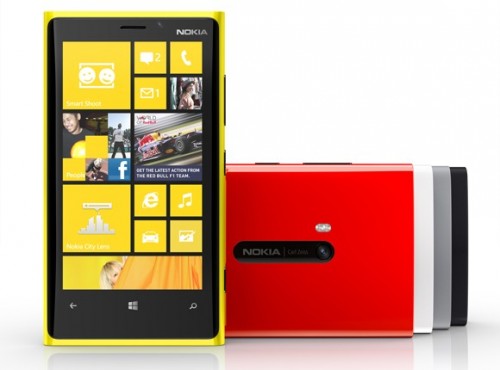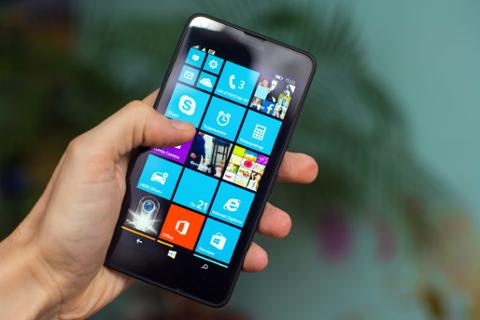 Nokia's Lumia 920 running Windows Phone 8.[/caption] Big projects sometimes fail, no matter how much money, time, effort and brainpower is devoted to making them succeed. Big-budget movies and video games end up returning a mere fraction of their budget; high-profile startups release products that fail to impact the market; beautiful pieces of hardware gather dust on store-shelves. Microsoft is trying very hard to ensure that Windows Phone is a big project that doesn’t fail. In the two years since the platform’s launch, however, it’s failed to take much territory from Apple’s iOS and Google Android, both of which split the substantial majority of the mobile market between them. According to research firm Gartner, Microsoft’s share of the worldwide smartphone market stands at 2.7 percent, lagging behind Google Android at 64.1 percent, Apple’s iOS at 18.8 percent, Symbian (which Nokia largely abandoned in favor of Windows Phone) at 5.9 percent, and BlackBerry at 5.2 percent. That’s in spite of a huge push by Nokia to promote its new lines of Windows Phone devices. Now Microsoft is ramping up the marketing campaign for Windows Phone 8, the successor to Windows Phone 7.x. The new platform shares a kernel, file system, graphics support, and other elements with Windows 8, creating a tight link between the two platforms. While that could draw more attention to Microsoft’s smartphone platform—something it really needs—the recoding leaves Windows Phone 7.x owners without a clear upgrade path; the latter won’t be able to run Windows Phone 8 apps, and Microsoft has declined to say whether more evolved software versions will appear beyond the upcoming Windows Phone 7.8. Based on Microsoft’s last two years in the smartphone game, here are some possible ideas for ensuring that Windows Phone 8 proves something of a success—or at least not an enormous marketplace bomb:
Nokia's Lumia 920 running Windows Phone 8.[/caption] Big projects sometimes fail, no matter how much money, time, effort and brainpower is devoted to making them succeed. Big-budget movies and video games end up returning a mere fraction of their budget; high-profile startups release products that fail to impact the market; beautiful pieces of hardware gather dust on store-shelves. Microsoft is trying very hard to ensure that Windows Phone is a big project that doesn’t fail. In the two years since the platform’s launch, however, it’s failed to take much territory from Apple’s iOS and Google Android, both of which split the substantial majority of the mobile market between them. According to research firm Gartner, Microsoft’s share of the worldwide smartphone market stands at 2.7 percent, lagging behind Google Android at 64.1 percent, Apple’s iOS at 18.8 percent, Symbian (which Nokia largely abandoned in favor of Windows Phone) at 5.9 percent, and BlackBerry at 5.2 percent. That’s in spite of a huge push by Nokia to promote its new lines of Windows Phone devices. Now Microsoft is ramping up the marketing campaign for Windows Phone 8, the successor to Windows Phone 7.x. The new platform shares a kernel, file system, graphics support, and other elements with Windows 8, creating a tight link between the two platforms. While that could draw more attention to Microsoft’s smartphone platform—something it really needs—the recoding leaves Windows Phone 7.x owners without a clear upgrade path; the latter won’t be able to run Windows Phone 8 apps, and Microsoft has declined to say whether more evolved software versions will appear beyond the upcoming Windows Phone 7.8. Based on Microsoft’s last two years in the smartphone game, here are some possible ideas for ensuring that Windows Phone 8 proves something of a success—or at least not an enormous marketplace bomb:
How Windows Phone 8 Can Succeed
[caption id="attachment_4425" align="aligncenter" width="500"]  Nokia's Lumia 920 running Windows Phone 8.[/caption] Big projects sometimes fail, no matter how much money, time, effort and brainpower is devoted to making them succeed. Big-budget movies and video games end up returning a mere fraction of their budget; high-profile startups release products that fail to impact the market; beautiful pieces of hardware gather dust on store-shelves. Microsoft is trying very hard to ensure that Windows Phone is a big project that doesn’t fail. In the two years since the platform’s launch, however, it’s failed to take much territory from Apple’s iOS and Google Android, both of which split the substantial majority of the mobile market between them. According to research firm Gartner, Microsoft’s share of the worldwide smartphone market stands at 2.7 percent, lagging behind Google Android at 64.1 percent, Apple’s iOS at 18.8 percent, Symbian (which Nokia largely abandoned in favor of Windows Phone) at 5.9 percent, and BlackBerry at 5.2 percent. That’s in spite of a huge push by Nokia to promote its new lines of Windows Phone devices. Now Microsoft is ramping up the marketing campaign for Windows Phone 8, the successor to Windows Phone 7.x. The new platform shares a kernel, file system, graphics support, and other elements with Windows 8, creating a tight link between the two platforms. While that could draw more attention to Microsoft’s smartphone platform—something it really needs—the recoding leaves Windows Phone 7.x owners without a clear upgrade path; the latter won’t be able to run Windows Phone 8 apps, and Microsoft has declined to say whether more evolved software versions will appear beyond the upcoming Windows Phone 7.8. Based on Microsoft’s last two years in the smartphone game, here are some possible ideas for ensuring that Windows Phone 8 proves something of a success—or at least not an enormous marketplace bomb:
Nokia's Lumia 920 running Windows Phone 8.[/caption] Big projects sometimes fail, no matter how much money, time, effort and brainpower is devoted to making them succeed. Big-budget movies and video games end up returning a mere fraction of their budget; high-profile startups release products that fail to impact the market; beautiful pieces of hardware gather dust on store-shelves. Microsoft is trying very hard to ensure that Windows Phone is a big project that doesn’t fail. In the two years since the platform’s launch, however, it’s failed to take much territory from Apple’s iOS and Google Android, both of which split the substantial majority of the mobile market between them. According to research firm Gartner, Microsoft’s share of the worldwide smartphone market stands at 2.7 percent, lagging behind Google Android at 64.1 percent, Apple’s iOS at 18.8 percent, Symbian (which Nokia largely abandoned in favor of Windows Phone) at 5.9 percent, and BlackBerry at 5.2 percent. That’s in spite of a huge push by Nokia to promote its new lines of Windows Phone devices. Now Microsoft is ramping up the marketing campaign for Windows Phone 8, the successor to Windows Phone 7.x. The new platform shares a kernel, file system, graphics support, and other elements with Windows 8, creating a tight link between the two platforms. While that could draw more attention to Microsoft’s smartphone platform—something it really needs—the recoding leaves Windows Phone 7.x owners without a clear upgrade path; the latter won’t be able to run Windows Phone 8 apps, and Microsoft has declined to say whether more evolved software versions will appear beyond the upcoming Windows Phone 7.8. Based on Microsoft’s last two years in the smartphone game, here are some possible ideas for ensuring that Windows Phone 8 proves something of a success—or at least not an enormous marketplace bomb:
 Nokia's Lumia 920 running Windows Phone 8.[/caption] Big projects sometimes fail, no matter how much money, time, effort and brainpower is devoted to making them succeed. Big-budget movies and video games end up returning a mere fraction of their budget; high-profile startups release products that fail to impact the market; beautiful pieces of hardware gather dust on store-shelves. Microsoft is trying very hard to ensure that Windows Phone is a big project that doesn’t fail. In the two years since the platform’s launch, however, it’s failed to take much territory from Apple’s iOS and Google Android, both of which split the substantial majority of the mobile market between them. According to research firm Gartner, Microsoft’s share of the worldwide smartphone market stands at 2.7 percent, lagging behind Google Android at 64.1 percent, Apple’s iOS at 18.8 percent, Symbian (which Nokia largely abandoned in favor of Windows Phone) at 5.9 percent, and BlackBerry at 5.2 percent. That’s in spite of a huge push by Nokia to promote its new lines of Windows Phone devices. Now Microsoft is ramping up the marketing campaign for Windows Phone 8, the successor to Windows Phone 7.x. The new platform shares a kernel, file system, graphics support, and other elements with Windows 8, creating a tight link between the two platforms. While that could draw more attention to Microsoft’s smartphone platform—something it really needs—the recoding leaves Windows Phone 7.x owners without a clear upgrade path; the latter won’t be able to run Windows Phone 8 apps, and Microsoft has declined to say whether more evolved software versions will appear beyond the upcoming Windows Phone 7.8. Based on Microsoft’s last two years in the smartphone game, here are some possible ideas for ensuring that Windows Phone 8 proves something of a success—or at least not an enormous marketplace bomb:
Nokia's Lumia 920 running Windows Phone 8.[/caption] Big projects sometimes fail, no matter how much money, time, effort and brainpower is devoted to making them succeed. Big-budget movies and video games end up returning a mere fraction of their budget; high-profile startups release products that fail to impact the market; beautiful pieces of hardware gather dust on store-shelves. Microsoft is trying very hard to ensure that Windows Phone is a big project that doesn’t fail. In the two years since the platform’s launch, however, it’s failed to take much territory from Apple’s iOS and Google Android, both of which split the substantial majority of the mobile market between them. According to research firm Gartner, Microsoft’s share of the worldwide smartphone market stands at 2.7 percent, lagging behind Google Android at 64.1 percent, Apple’s iOS at 18.8 percent, Symbian (which Nokia largely abandoned in favor of Windows Phone) at 5.9 percent, and BlackBerry at 5.2 percent. That’s in spite of a huge push by Nokia to promote its new lines of Windows Phone devices. Now Microsoft is ramping up the marketing campaign for Windows Phone 8, the successor to Windows Phone 7.x. The new platform shares a kernel, file system, graphics support, and other elements with Windows 8, creating a tight link between the two platforms. While that could draw more attention to Microsoft’s smartphone platform—something it really needs—the recoding leaves Windows Phone 7.x owners without a clear upgrade path; the latter won’t be able to run Windows Phone 8 apps, and Microsoft has declined to say whether more evolved software versions will appear beyond the upcoming Windows Phone 7.8. Based on Microsoft’s last two years in the smartphone game, here are some possible ideas for ensuring that Windows Phone 8 proves something of a success—or at least not an enormous marketplace bomb:

